JOYO American Sound Review: Classic Fender Amp Tone for $3o?!

As the world continues to evolve, so too do the tools that guitarists use to create their music. A great example of this has been the evolution of "amp in a box" pedals. They started in the 70s and 80s as nothing more than distortion/overdrive pedals with some fixed EQ, but in recent years have begun to replicate the sound and feel of real tube amplifiers.
But progress doesn't just innovate. It also makes things more affordable, and in the case of the JOYO American Sound, shockingly affordable.
I've been searching for a proper ampless guitar rig for the past few months. Most of the time I'm playing guitar at night, in an apartment, with my kids sleeping in the next room over. I'd been considering options from Universal Audio, IK Multimedia, and more, but stumbled across a recommendation on a forum for the JOYO American Sound.
At first, I refused to believe it. There was no way a $30 pedal could provide convincing amplifier simulation. Boy, was I wrong.
JOYO American Sound First Impressions
Let me start off by saying that I'm strictly using the JOYO American Sound as an amp replacement. My signal chain during testing of the pedal has been to run my guitar direct into a Boss SD-1, followed by the JOYO American Sound straight into a JHS 3-Series Reverb.
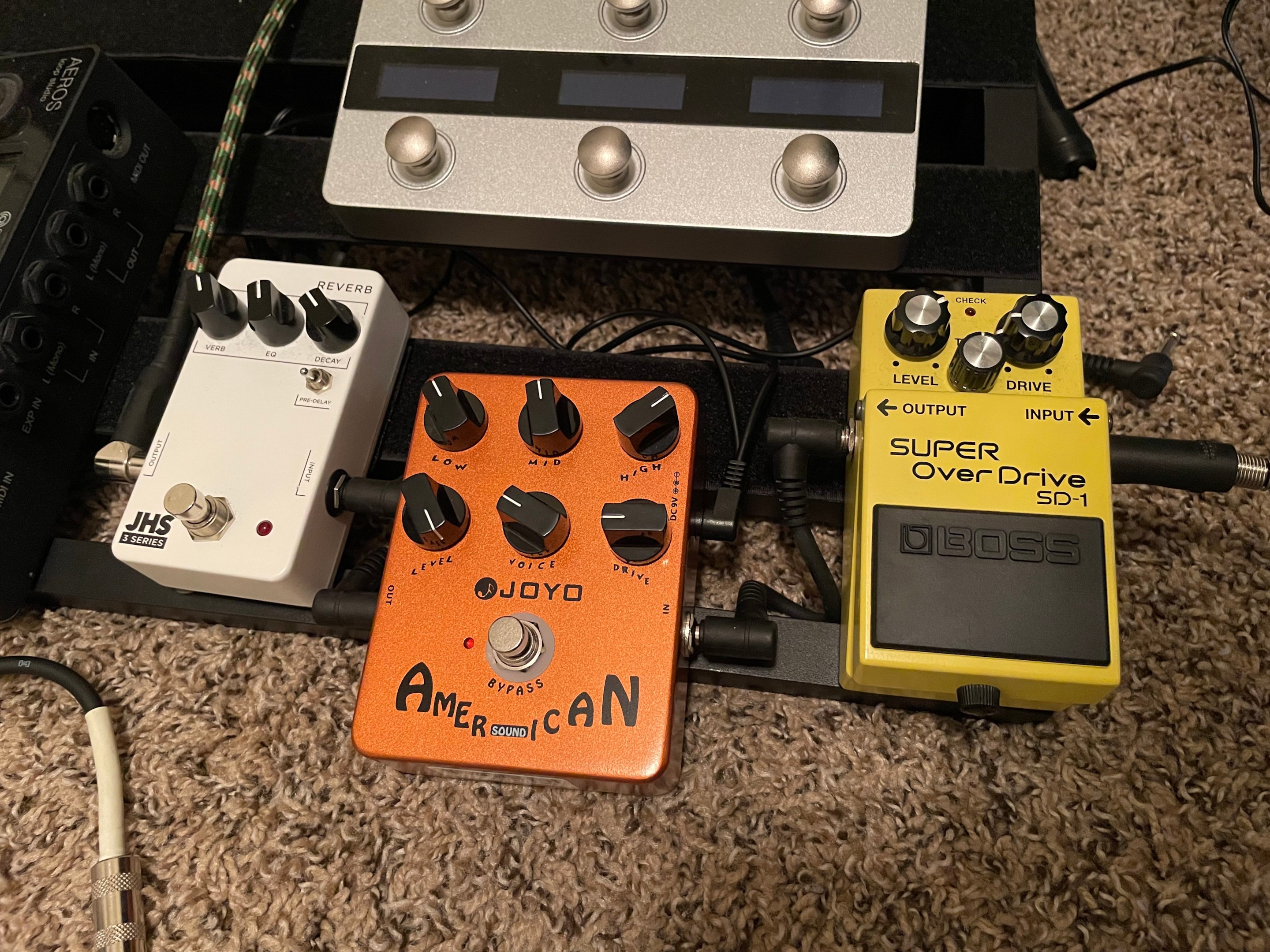
After the reverb, the signal runs into my M-Audio Air 192 | 6 audio interface, after-which I listen either through some Mackie 3" near-field Monitors or a pair of ATH-M50x headphones.
When I first unboxed the pedal, I chuckled a bit at the packaging before being surprised to find that I actually liked the way the orange stove varnish finish looked. When looking at the pedal in videos and photos online I had thought it looked like an odd color, but was glad to find that wasn't the case in person.
The Amer sound ican still throws me off though...
Next, I plugged it in-or at least tried to. Oddly enough my patch cable wouldn't go into the output jack. What I found is that of the two sets of patch cables I had on hand, one would fit nicely into the JOYO American Sound, but the other was acting as if it was too wide for the port.
This could be an issue with my patch cables, but I haven't had it occur with any of my other pedals. Perhaps the tolerances for the jacks on the the American Sound are tighter than normal? In any case, I was able to proceed, and if I tried hard enough I could also get the patch cables in.
After figuring out the cable situation, I began trying some of the settings shown in the Blonde section of the Tech 21 Character Series owner's manual. (Relevant section also pictured below)
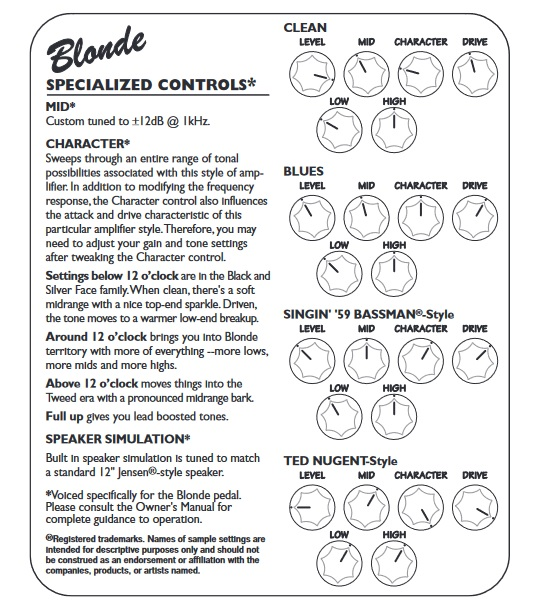
If you're asking why I consulted a "random" manual, the answer is that the JOYO American Sound is actually a clone of the Tech 21 Blonde, with one subtle change. (Which we'll get to later.)
The sounds shown above all were great, and I knew off the bat that this pedal was going to be a keeper.
"I knew off the bat that this pedal was going to be a keeper."
Of the classic sounds above, I found myself liking the Singin' 59 Bassman-Style. The driven sounds you can get out of this pedal are truly surprising, but as time went on, I began to also appreciate the cleaner tones...
How Does the American Sound Respond to All Your Other Pedals?
As I'm writing this, the knobs on my American Sound are at the following positions:
- Low - 11 o'clock
- Mid - 11:30
- High - 2 o'clock
- Level - 5 o'clock/dimed
- Voice - 10 o'clock
- Drive - 9 o'clock
To me this acts as a great pedal platform at these settings, providing wonderful clean tones with subtle overdrive that pair nicely with thick reverb as well as serve as a great base for excellent lead tones with the overdrive sound from the SD-1.
It was at this point in testing and reviewing the amp sim pedal, that I intended to experiment more with the various positions of the knobs to see the EQ and overdrive response. However... I was having so much fun with the JOYO pedal at this settings that I just kept playing.
Before I knew it, I was pulling up Ultimate Guitar and learning tabs for new songs, and the Amp and SD-1 combo were so good as is, that I stopped thinking about tweaking how my guitar sounded and just played.
This is, I must admit, some of the highest praise I can give a piece of gear. And, upon proof reading, I noticed I didn't even call the JOYO American Sound a pedal in the last paragraph. I called it an amplifier. A subconscious slip that reinforces the idea that for me, this $30 piece of equipment sounds just as good as a mic'd up fender amp.
At this point, I think I've made it pretty clear that this pedal is great for replicating classic sounds from fender amplifiers, and I'm not the only one. Countless recordings have been made with the JOYO American Sound, at least according to users on guitar forums and even artists on YouTube.
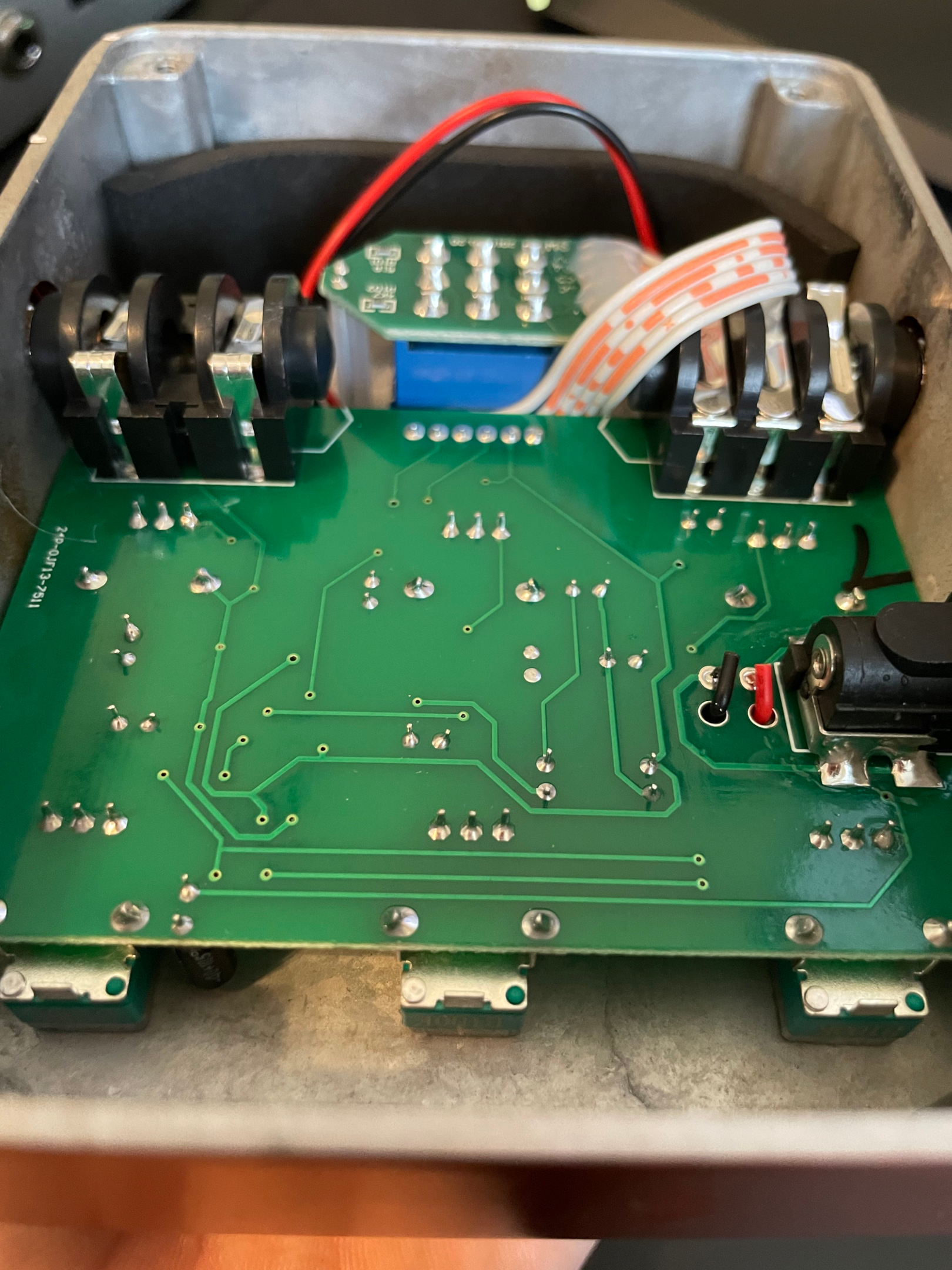
How Does the JF-14 American Sound Work?
Earlier, I mentioned that the American Sound was a clone of the Tech 21 Blonde. As with many clones, it's not an exact copy, but it's pretty darn close.
For starters, the Tech 21 Blonde is an analog amp sim pedal designed to recreate sounds from fender style tube amps such as the Fender Tweed and Fender 57 Deluxe. It had two versions, a v1 and v2. The only difference between them is that the v2 features a speaker sim button, which when pressed enables or disables the inbuilt cabinet emulation.
The JOYO American Sound appears to be a copy of the v1, meaning that built in cabinet emulation can't be turned off without a Mod, which we'll discuss near the end of this article.
Since the pedal is so widely used and recommended, people have done some digging comparing it directly to the Blondes, and we can piggy back on their work.
In particular, J-Flanders did some direct comparisons of the frequency response for each pedal and posted the results on TDPRI.
How the Three Band EQ Shapes Your Sound
What it tells us is revealing. For treble and bass, the JOYO is nearly identical to the Tech 21 amp sim, but with extended range and presence. The Mids do have a clear difference with the Tech 21 Blonde's mid frequency centered around 1000hz and the American Sound's at 400hz.
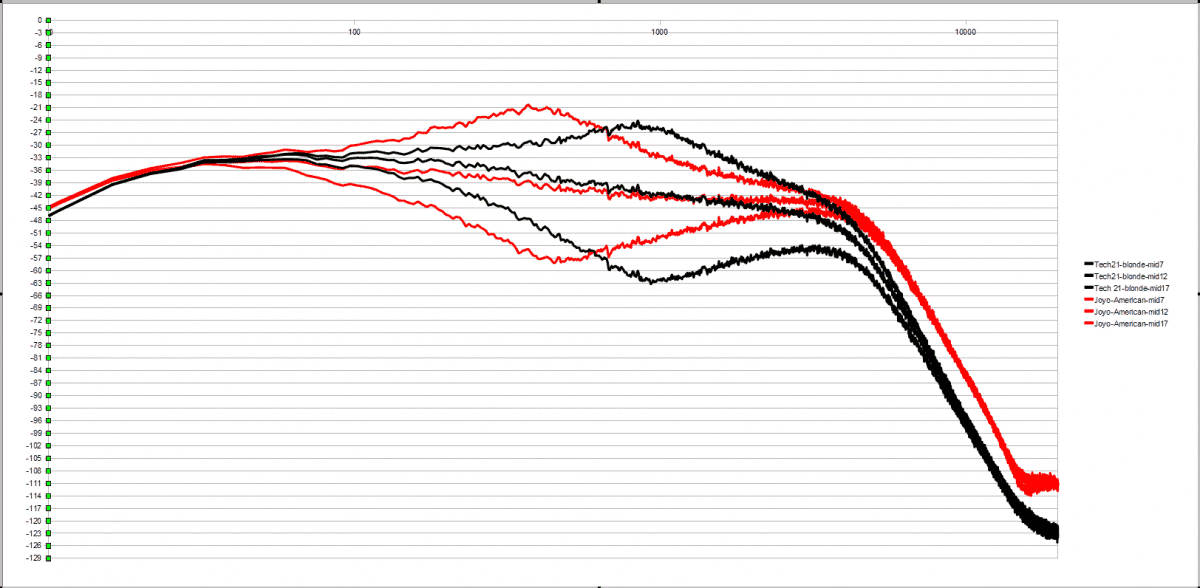
Both pedals feature active EQs, which is to say that the knobs interact with each other. Turn all of the EQ knobs down and the sound level is reduced signficantly, likewise, if you dime each knob you'll get a slight boost to your overall volume.
Understanding the Voice Knob
Furthermore, J-Flanders' testing reveals to us how the Voice/Character knob works.
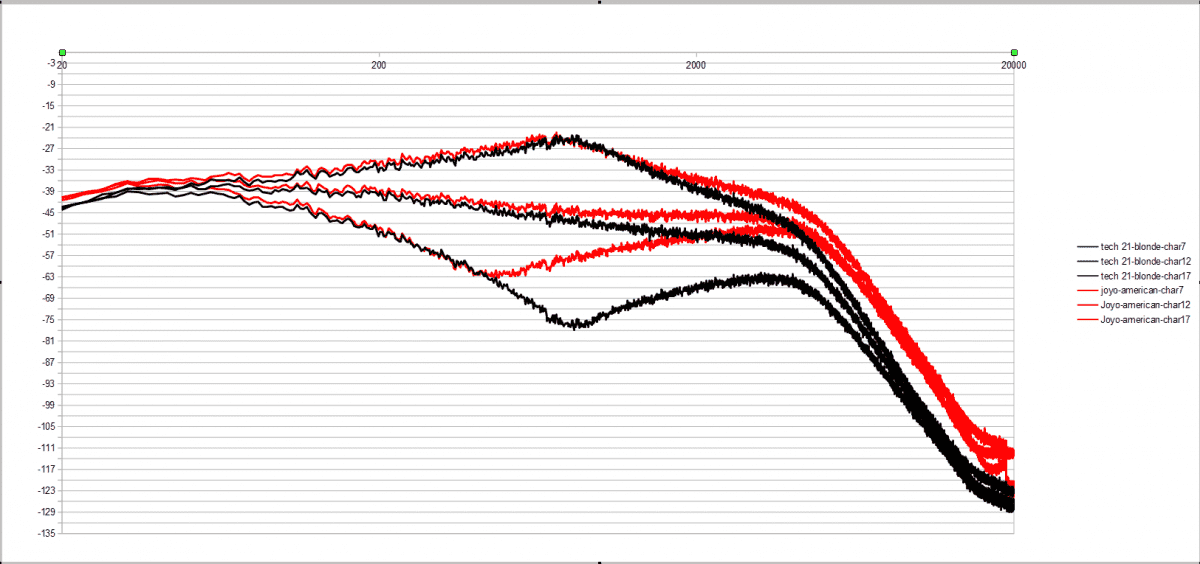
It's another mid control, but this time it's positioned before the clipping/distortion in the amp pedal's circuit. This causes it to alter the character of the built in distortion (or overdrive) by determining which frequencies are more (or less) distorted. The knob goes from cutting 400hz to boosting 800hz.
A Closer Look at the Cab/Speaker Simulation
Finally, he take a look at the built in cab sim to see how it shapes the tone. This is the last step in the pedal's circuit and overall looks to be a pretty well done cabinet simulation for fender style amps.
First up, since the Tech 21 Blonde features a cab sim button, we can compare what the frequency response is like with and without.
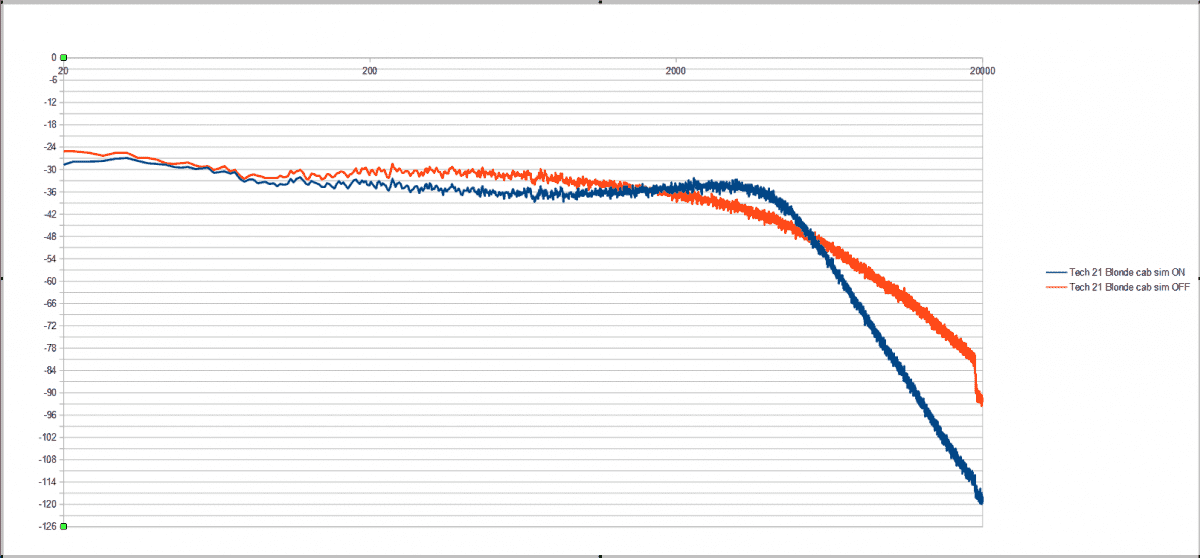
As you can see, the inbuilt cabinet emulation gives a slight boost to the top end before taking a sharp dive for less high end frequencies in the end mix. There's also a mellowing/removal of the hump in the mid/bass frequencies, which is subtle but helps with giving the pedal some of it's warm sound.
Obviously we can't say that the JOYO American Sound's cab sim impacts the output in the same exact way, but given how close the pedals are otherwise, it's certainly going to be very close.
Next up, J-Flanders shows the JOYO compared with several other popular amp simulators (at least for the time this testing was done).

As you can see, the overall shape of the frequency response for the JOYO American Sound is very similar to that of other options. There are only two major differences in the sound.
First, the low end isn't rolled off like on a real deal Fender Amp or even the nicer cabinet/amp simulators.
And second, the curve is much smoother than that of the digital options. This is because the built in cabinet emulation is analog, not digital, so it's using a clever combination of resistors to shape the EQ, similar to a tone knob.
On the other hand, more complex and/or digital recreations can go beyond just the broad EQ to also simulate the cabinet/room/mic resonances, comb-filtering and phase cancellation. This is why their curves are so irregular.
Modding the JOYO American Sound to Bypass the Cab Sim
Given the above, if we could remove the built in cab sim from the JOYO American Sound and run it though an IR Cab Sim, in theory we should have an even more realistic tone. This isn't to say that the built in cab sim is bad, it sounds good, we can just hypothetically make an even better amp sim pedal.
This guide comes from freestompboxes.org, and should work for any of the modern JOYO pedals, but won't work if you've got an older circuit board, or if JOYO changes the layout of the circuit board in the future.
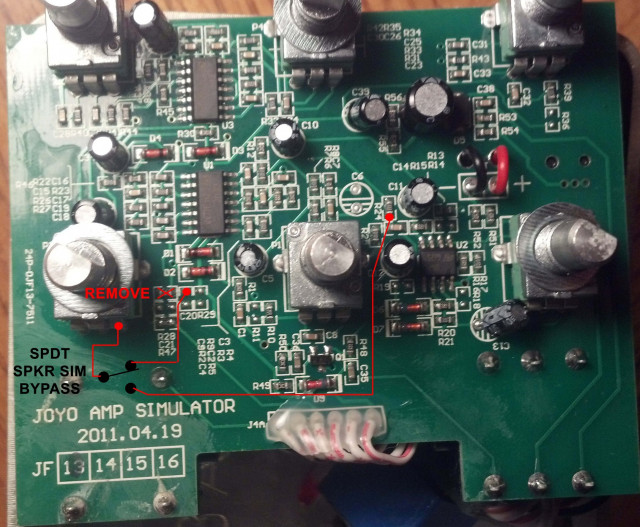
In the image below, remove the 0 ohm resistor where shown, and then solder wire in each of the places shown. This circuit is designed to incorporate a bypass switch, but if you wanted to make the pedal work strictly without the amp sim, you could do so by making your jumper wire duplicate the switch in the down position.
One thing to note is that there will be a difference in volume when you remove the amp sim. If you'd like to avoid that, you can solder a resistor between the values of 2k2 to 3k9 (try 3k3) on the side of the switch which disengages the speaker sim.
I'll likely take on this mod after I get some Cab Sim IR's that I'm particular fond of, and when I do, I'll be sure to record it and upload a video tutorial for anyone wishing to follow in my steps. If done properly, it should increase the versatility and realism of the amp in a pedal greatly.
Conclusion
Should you buy the JOYO American Sound (or any of their Amp Simulators)?
The short answer, yes.
These pedals offer great sound at an incredible bargain. It's not too hard to think of a use case for them even if you've already got a fender style tube amp. You could use one as a backup in case your amp fails, you need to play late at night through headphones, as a direct recording solution if you don't have a mic or great acoustics, or on a silent stage (common in worship bands these days).
It's also a great way to dabble and test the waters with an ampless guitar rig, something that I fully intend to do more of in the future.